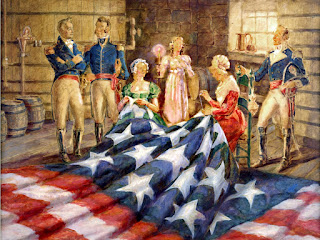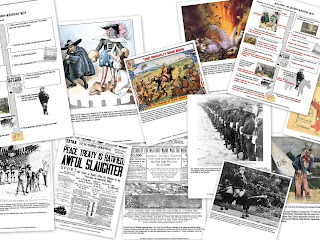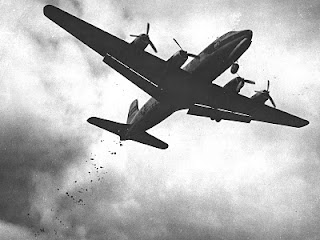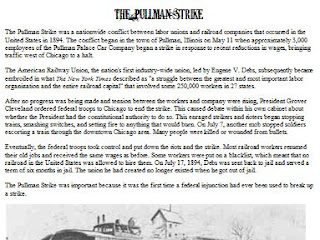American History etiketine sahip kayıtlar gösteriliyor. Tüm kayıtları göster
American History etiketine sahip kayıtlar gösteriliyor. Tüm kayıtları göster
8 Kasım 2020 Pazar
28 Şubat 2015 Cumartesi
The Strangest Battle of the Second World War
| Castle Itter in the 1970s |
The Castle And Its Prisoners:
The castle was located in western Austria in the quiet village of Itter. It was privately owned but was seized by the German Army (Wehrmacht) in 1943 for use as a prison camp under administration of the infamous Dachau Concentration Camp.
Its prisoners were rather famous VIPs who included tennis star Jean Borotra (later General Commissioner of Sports in the Vichy regime, former prime minister Édouard Daladier, Charles de Gaulle's elder sister Marie-Agnès Cailliau, former commander-in-chief Maxime Weygand, former prime minister Paul Reynaud, former commander-in-chief Maurice Gamelin (instrumental in the Phony War), right-wing leader François de La Rocque (the leader of the right-wing Croix de Feu movement), and trade union leader Léon Jouhaux.
The Battle:
On 4 May, the garrison of the castle abandoned the castle, having realised that German surrender was imminent. The French prisoners took control of the castle and armed themselves with whatever weaponry remained. A Yugoslavian prisoner, Zvonimir Čučković, was sent to find help. Zvonimir encountered elements of the American 103rd Infantry Division near the city of Innsbruck who agreed to rescue the prisoners. A defected German unit under the command of Major Josef Gangl which collaborated with the Austrian resistance and later surrendered to the Americans, agreed to accompany the rescue.
The rescue force consisted of 14 American soldiers, 10 defected German soldiers and a Sherman tank. Upon reaching the castle, the French prisoners were dismayed at the small size of the rescue but however had elected to focused on fortifying the castle in anticipation of a Waffen-SS assault on the castle. The Sherman tank was placed towards the entrance whilst positions were taken on the towers. The Allies were joined by a defected Waffen-SS officer who was recovering in the nearby village.
On the morning of the 5th, the castle came under attack from 100-150 soldiers of the 17th Waffen-SS Panzergrenadier division. Major Gangl telephoned in Austrian resistance members in the vicinity for reinforcements, 3 Austrian resistance members arrived soon after. Despite being ordered to take refuge inside the castle, French prisoners joined the battle alongside the Americans and Germans. The battle raged on for six hours, resulting in the destruction of the Sherman tank and the death of Major Gangl, before the SS were defeated by a relief force from the American 142nd Infantry Regiment.
Further reading:
US news report during the war:
2 Ağustos 2013 Cuma
Freshen Up With Archaeology Friday (Post X)
Coffin within a coffin found near Richard III site
Archaeologists have unearthed a mysterious coffin-within-a-coffin near the final resting place of Richard III.
| The coffin-in-a-coffin. (Photo from the University of Leicester) |
The University of Leicester team lifted the lid of a medieval stone coffin this week -- the final week of their second dig at the Grey Friars site, where the medieval king was discovered in September.
This is the first fully intact stone coffin to be discovered in Leicester in controlled excavations -- and is believed to contain one of the friary's founders or a medieval monk.Within the stone coffin, they found an inner lead coffin -- and will need to carry out further analysis before they can open the second box.
Archaeologists have taken the inner lead coffin to the University's School of Archaeology and Ancient History, and will carry out tests to find the safest way of opening it without damaging the remains within.
It took eight people to carefully remove the stone lid from the outer coffin -- which is 2.12 metres long, 0.6 metres wide at the "head" end, 0.3 metres wide at the "foot" end and 0.3 metres deep.
The inner coffin is likely to contain a high-status burial -- though we don't currently know who it contains.
Full article
Oldest European fort in inland America discovered in the Appalachian mountains:
 |
| The uncovered fort (Photo from the University of Michigan) |
The remains of the earliest European fort in the interior of what is now the United States have been discovered by a team of archaeologists, providing new insight into the start of the U.S. colonial era and the all-too-human reasons spoiling Spanish dreams of gold and glory.
Spanish Captain Juan Pardo and his men built Fort San Juan in the foothills of the Appalachian Mountains in 1567, nearly 20 years before Sir Walter Raleigh's "lost colony" at Roanoke and 40 years before the Jamestown settlement established England's presence in the region.
"Fort San Juan and six others that together stretched from coastal South Carolina into eastern Tennessee were occupied for less than 18 months before the Native Americans destroyed them, killing all but one of the Spanish soldiers who manned the garrisons," said University of Michigan archaeologist Robin Beck. Beck, an assistant professor in the U-M Department of Anthropology and assistant curator at the U-M Museum of Anthropology, is working with archaeologists Christopher Rodning of Tulane University and David Moore of Warren Wilson College to excavate the site near the city of Morganton in western North Carolina, nearly 300 miles from the Atlantic Coast.
The Berry site, named in honor of the stewardship of landowners James and the late Pat Berry, is located along a tributary of the Catawba River and was the location of the Native American town of Joara, part of the mound-building Mississippian culture that flourished in the southeastern U.S. between 800 and about 1500 CE.
In 2004, with support from the National Geographic Society and the National Science Foundation, Beck and his colleagues began excavating several of the houses occupied by Spanish soldiers at Joara, where Pardo built Fort San Juan. Pardo named this small colony of Spanish houses Cuenca, after his own hometown in Spain. Yet the remains of the fort itself eluded discovery until last month.
"We have known for more than a decade where the Spanish soldiers were living," Rodning said. "This summer we were trying to learn more about the Mississippian mound at Berry, one that was built by the people of Joara, and instead we discovered part of the fort. For all of us, it was an incredible moment."
Using a combination of large-scale excavations and geophysical techniques like magnetometry, which provides x-ray-like images of what lies below the surface, the archaeologists have now been able to identify sections of the fort's defensive moat or ditch, a likely corner bastion and a graveled surface that formed an entryway to the garrison.
Excavations in the moat conducted in late June reveal it to have been a large V-shaped feature measuring 5.5 feet deep and 15 feet across. Spanish artifacts recovered this summer include iron nails and tacks, Spanish majolica pottery, and an iron clothing hook of the sort used for fastening doublets and attaching sword scabbards to belts.
Fort San Juan was the first and largest of the garrisons that Pardo founded as part of an ambitious effort to colonize the American South. Pedro Menéndez de Avilés, who had established the Spanish colonies of St. Augustine and Santa Elena in 1565 and 1566, respectively, spearheaded this effort. Of the six garrisons that Pardo built, Fort San Juan is the only one to have been discovered by archaeologists.
Today's featured reading:
- Archaeologists and modern day witch doctors, by Phillip Segadika, Chief Curator at the Botswana National Museum.
8 Mart 2013 Cuma
The Surrender of Japan: A Brief Overview
| Japanese foreign affairs minister Mamoru Shigemitsu signs the Japanese Instrument of Surrender on board USS Missouri as General Richard K. Sutherland watches, September 2, 1945 |
| The USS Missouri on the day of the signing, 2 September 1945 |
| General of the Army Douglas MacArthur signing the Instrument of Surrender on behalf of the Allied Powers |
 |
| The Japanese Instrument of Surrender (click for larger image) |
The state of war between Japan and the Allies formally ended when the Treaty of San Francisco came into force on April 28, 1952. Four more years passed before Japan and the Soviet Union signed the Soviet–Japanese Joint Declaration of 1956, which formally brought an end to their state of war.
| Representatives of Japan stand aboard USS Missouri prior to signing of the Instrument of Surrender. |
19 Şubat 2013 Salı
Spanish American War Timeline Using Primary Sources
American History
group work
imperialism
lesson plan
spanish american war
US history
worksheet.
world history
Tarihçi
Comment
Our newest lesson covers the "splendid little war" known as the Spanish American War. Although brief, this war is essential for students to understand how America transitioned into becoming a world power.
In this lesson, students analyze 10 primary sources from the Spanish American War, including cartoons, newspapers, lithographs, maps, and pictures all related to each aspect of the war.
In this lesson, students analyze 10 primary sources from the Spanish American War, including cartoons, newspapers, lithographs, maps, and pictures all related to each aspect of the war.
Students then match these documents to questions along a timeline. The documents begin with a cartoon related to America protecting Cuba and move through the explosion on the USS Maine, the Teller & Platt Amendments, Rough Riders, Yellow Journalism, Buffalo Soldiers, Philippine-American War, and more.
Each task is of varying difficulty and caters to visual and kinesthetic learners in having them finishing sketches to reinforce concepts. An answer key is included and can be seen below. You can download this lesson for your classroom by clicking here. A free preview of all the documents in the lessons is available as well.
13 Şubat 2013 Çarşamba
"Uncle Wiggle Wings - The Candy Bomber " Berlin Airlift & Communism Story
American History
berlin airlift
Cold War
Germany
reading
US history
worksheet.
world history
Tarihçi
1 Comment
This lighthearted, heartwarming true story tells of American Air Force pilot Gail Halvorsen who flew supplies over Germany during the famous Berlin Airlift of 1948.
After the Soviet Union cut off Berlin from West Germany, the US plan to fly in supplies rather than break the blockade famously embarrassed the Soviet Union. This tension eventually led to the building of the Berlin Wall.
During his flights, Halvorsen would drop candy out of his plane to the children of Berlin, earning him the nickname "Uncle Wiggle Wings the Candy Bomber".
This worksheet includes one page on this fantastic story, mixing essential Common Core knowledge like the Berlin Airlift, Allied Powers, President Truman, Stalin, and more with the amusing tale of Uncle Wiggle Wings. My students really enjoyed this story and were able to relate very well to the children of Berlin.
Just the title of the story had them laughing and anxious to read it!
You can download this worksheet for your students by clicking here. An answer key is included for your convenience.
After the Soviet Union cut off Berlin from West Germany, the US plan to fly in supplies rather than break the blockade famously embarrassed the Soviet Union. This tension eventually led to the building of the Berlin Wall.
During his flights, Halvorsen would drop candy out of his plane to the children of Berlin, earning him the nickname "Uncle Wiggle Wings the Candy Bomber".
This worksheet includes one page on this fantastic story, mixing essential Common Core knowledge like the Berlin Airlift, Allied Powers, President Truman, Stalin, and more with the amusing tale of Uncle Wiggle Wings. My students really enjoyed this story and were able to relate very well to the children of Berlin.
Just the title of the story had them laughing and anxious to read it!
You can download this worksheet for your students by clicking here. An answer key is included for your convenience.
12 Şubat 2013 Salı
American Imperialism: World Leader or Bully?
American History
classroom activity
downloads
group work
imperialism
lesson plan
US history
worksheet.
Tarihçi
Comment
This downloadable worksheet combines several layers of Bloom's Taxonomy, including comprehension, analysis, and critical thinking as students review 10 US actions during the Age of Imperialism.
Included are the US purchase of Alaska, Spanish-American War, building of the Panama Canal, the annexation of Hawaii, and more. For each event, students must determine whether they feel the US was acting like a "world leader" promoting good or a "bully" acting in its own self-interest.
Whatever their decision, they must provide evidence to back up their claim. After completing the chart, students then determine whether America overall acted more like a World Leader or a World Bully and compose a short persuasive essay on their choice.
I did not include an answer key because each aspect of this is opinion-based and arguments could be made for either. However, if you would like a completed student sample, please let me know and I will supply one!
Click here to download this lesson for your student to use today!
Included are the US purchase of Alaska, Spanish-American War, building of the Panama Canal, the annexation of Hawaii, and more. For each event, students must determine whether they feel the US was acting like a "world leader" promoting good or a "bully" acting in its own self-interest.
Whatever their decision, they must provide evidence to back up their claim. After completing the chart, students then determine whether America overall acted more like a World Leader or a World Bully and compose a short persuasive essay on their choice.
I did not include an answer key because each aspect of this is opinion-based and arguments could be made for either. However, if you would like a completed student sample, please let me know and I will supply one!
Click here to download this lesson for your student to use today!
11 Şubat 2013 Pazartesi
Turning Paper Boxes into Picket Signs - Strikes & Labor Lesson Plan
American History
cooperative learning
group work
industrial revolution
labor unions
lesson plan
trikes
US history
Tarihçi
Comment
In this creative cooperative learning activity, students create picket signs from old paper boxes that tell the story of some of the most famous labor clashes in American History.
Included are 7 one-page stories on each of the following: The Homestead Strike, Haymarket Affair,Pullman Strike, Ludlow Massacre, Great Railroad Strike of 1877, Flint Sit-Down Strike, and Memorial Day Massacre.
In groups, students then complete the reading and create a picket sign that tells the story of that strike and present them to the class:
As groups present, a Venn Diagram helps students organize similarities and differences between the different strikes:
Lastly, students complete a set of comprehension questions. A rubric for the presentation is included as well as an page describing the procedures in detail and pictures of completed examples.
This can be downloaded from this link and is a very fun activity that your student will remember and enjoy!
http://www.teacherspayteachers.com/Product/Major-American-Strikes-Labor-Issues-Picket-Signs-Lesson
Included are 7 one-page stories on each of the following: The Homestead Strike, Haymarket Affair,Pullman Strike, Ludlow Massacre, Great Railroad Strike of 1877, Flint Sit-Down Strike, and Memorial Day Massacre.
In groups, students then complete the reading and create a picket sign that tells the story of that strike and present them to the class:
As groups present, a Venn Diagram helps students organize similarities and differences between the different strikes:
Lastly, students complete a set of comprehension questions. A rubric for the presentation is included as well as an page describing the procedures in detail and pictures of completed examples.
This can be downloaded from this link and is a very fun activity that your student will remember and enjoy!
http://www.teacherspayteachers.com/Product/Major-American-Strikes-Labor-Issues-Picket-Signs-Lesson
21 Ocak 2013 Pazartesi
Gilded Age Robber Barons
American History
carnegie
Gilded Age
immigration
robber barons
rockefeller
US history
vanderbilt
Tarihçi
Comment
One topic from US History that has a particular resonance to today is the Gilded Age. The disparity between rich and poor and immigration issues make for easy connections to today's world.
This visually rich 20 slide powerpoint covers the major American "robber barons" of the Gilded Age and can be downloaded here. Rockefeller, Carnegie, Morgan, & Vanderbilt are featured with spectacular photos of them and their magnificent mansions.
Other slides feature political cartoons that highlight the public perception of their tactics.
The notes that accompany each slide cover basic, essential state and Common Core information students need to know about each topic. Your students will marvel at the Biltmore estate, gasp at JP Morgan's disfiguring rhinophyma, and easily understand the relationship of cheap, immigrant labor to the rise of monopolies.
Click here to download this fantastic powerpoint that you can use in your classes immediately!
This visually rich 20 slide powerpoint covers the major American "robber barons" of the Gilded Age and can be downloaded here. Rockefeller, Carnegie, Morgan, & Vanderbilt are featured with spectacular photos of them and their magnificent mansions.
Other slides feature political cartoons that highlight the public perception of their tactics.
The notes that accompany each slide cover basic, essential state and Common Core information students need to know about each topic. Your students will marvel at the Biltmore estate, gasp at JP Morgan's disfiguring rhinophyma, and easily understand the relationship of cheap, immigrant labor to the rise of monopolies.
Click here to download this fantastic powerpoint that you can use in your classes immediately!
28 Ağustos 2012 Salı
History in Focus: The Iran-Iraq War
(Note: History in Focus is a new post style where I discuss a topic simply by posting photos [and if applicable, videos] of the event in question. I often found that this helps the reader to understand a topic much more thoroughly).
The Iran-Iraq war was a devastating eight-year war fought between the two countries between September 1980 and August 1988. The war started with a simultaneous air and land Iraqi offensive onto Iran which caught the Iranians off guard (with Iran still reeling from the chaos caused via their revolution).
The Iraqis made early gains, capturing the strategic border city of Khorramshar after a lengthy and bloody siege (The city was nicknamed "Khunistan" [City of Blood] by both sides during the conflict) and initiated the siege of Abadan. Much of the city of Abadan, including the oil refinery which was one of the world's largest refinery with capacity of 680,000 barrels per day, was badly damaged and almost destroyed by the siege.
For much of 1981 and 1982, the Iraqi offensive halted in a stalemate. In 1982, Iraqi soldiers were repelled from Iranian territory and it seemed that the conflict would end with Iraq suing for peace. It did not, Iran was later on the offensive, dragging the war on for another six years.
The Iranian offensive was slowed down and eventually halted by the deployment of chemical weapons, mainly mustard gas, by the Iraqi army. Iraq would later use these weapons for the remainder of the war, most notably in the gassing of the Kurdish village of Halabja.
The war saw the constant bombardment, by both sides, of the other's cities and towns. Missiles and air raids were launched to bomb each other into submission. This was later dubbed as the "War of the Cities".
Tanker Wars:
The conflict spilled into the Persian Gulf; both countries produced large amounts of oil and it was viewed that attacking and disabling oil installations in the combatant's country would damage their economy and eventually bankrupt them. However, this mini-war caused the US navy (a navy stronger than both Iran's and Iraq's combined) to escort Gulf oil tankers; there were still incidents. Iraq 'accidentally' bombed a US warship and Iran's practice of laying mines in the sea (which had damaged a US frigate) caused an American strike on the Iranian navy, taking out five Iranian naval vessels.
After the USS Stark incident, American naval vessels were on high alert. In July 1988, the cruiser USS Vincennes shot down Iran Air Flight 655, killing all 290 passengers and crew on board. The American government claimed that the airliner had been mistaken for an Iranian F-14 Tomcat, and that the Vincennes was operating in international waters at the time and feared that it was under attack, which later appeared to be untrue.The Iranians, however, maintain that the Vincennes was in fact in Iranian territorial waters, and that the Iranian passenger jet was turning away and increasing altitude after take-off. U.S. Admiral William J. Crowe also admitted on Nightline that the Vincennes was inside Iranian territorial waters when it launched the missiles. The issue remains a controversial point in Iranian-American relations to this day.
Home Front:
As in WWI and WWII, the war brought in the massive pouring of military volunteers and aid to each country's armed forces.
International Reactions:
The UN deployed several observers to Iran to assess if chemical weapons were used and to report on how much were used.
Casualties (graphic):
The war left a million dead, and hundreds of thousands injured.
Peace:
Peace was achieved in 1988. 100,000+ civilians killed on both sides, 320,000–720,000 Iraqi soldiers and militia killed and 150,000–375,000 Iranian soldiers and militia killed. Over a trillion dollars in damages occurred. This was the longest conventional war of the 20th century and one of the most brutal.
Iraq erected 101 statues with pointing fingers towards Iran, six miles away from the border, in memory of Iraqis killed during the Iran-Iraq War. The statues were destroyed by the British on March 31, 2003.

The Iran-Iraq war was a devastating eight-year war fought between the two countries between September 1980 and August 1988. The war started with a simultaneous air and land Iraqi offensive onto Iran which caught the Iranians off guard (with Iran still reeling from the chaos caused via their revolution).
| Iraqi gains (between 1980-82) and Iranian gains (1982-88) |
 |
| Armed Iranian woman in Khorramshar during the siege |
| Oil wells on fire, outside Abadan, Iran. |
 |
| Iraqi artillery battalion. |
| Iraqi soldiers posing after a victory |
| Trench warfare was common, as in WWI. |
| Iraqi army and militia positions in the war (from HealingIraq.blogspot.com) |
 |
| The war saw the mass recruitment of child soldiers |
 |
| Child soldiers on the Iranian frontier |
 |
| Sudanese volunteers marching. They joined the Iraqi Army in 1983. |
| Iraqi tank and soldiers cross beyond the Karun river |
| Iraqi soldiers in combat. |
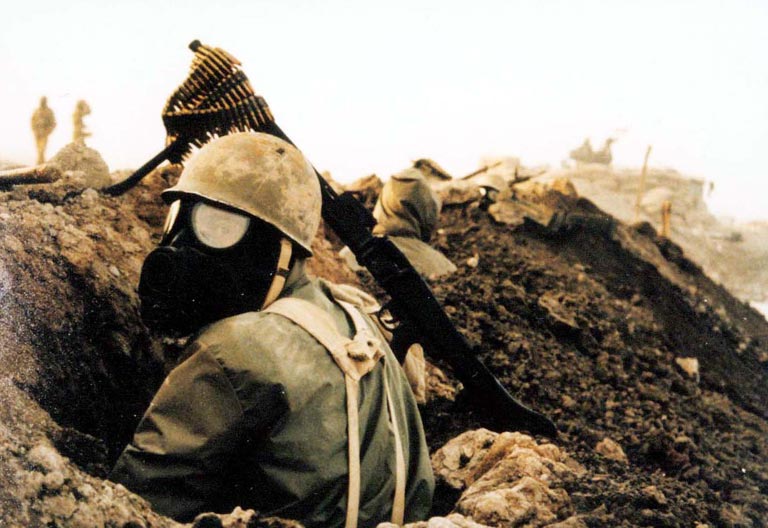 |
| Iranian soldier wears a gas mask and takes cover in a trench |
| Locations of the use of chemical weapons |
 |
| Iranian soldiers equipped with gas masks. It helped them survive. |
 |
| Victims of the gas attack at the Kurdish village of Halabja, Iraq. 5,000 died at least. |
 | |
| Kuwait was attacked by Iran in an airstrike over their support for Iraq |
| Iranian Revolutionary Guard mounting an Anti-Air gun in Iran |
 |
| Iranian children lie dead after a school was bombed in 1987 |
The conflict spilled into the Persian Gulf; both countries produced large amounts of oil and it was viewed that attacking and disabling oil installations in the combatant's country would damage their economy and eventually bankrupt them. However, this mini-war caused the US navy (a navy stronger than both Iran's and Iraq's combined) to escort Gulf oil tankers; there were still incidents. Iraq 'accidentally' bombed a US warship and Iran's practice of laying mines in the sea (which had damaged a US frigate) caused an American strike on the Iranian navy, taking out five Iranian naval vessels.
| Oil tanker scuttled in the Shatt al Arab waterway on Saddam's orders to prevent sea access to southern Iraq |
 |
| The USS Stark after being hit by an Iraqi fighter plane |
| Iranian boats like these littered the Gulf. |
| Oil tanker in flames after being hit by an Iranian missile. |
Home Front:
As in WWI and WWII, the war brought in the massive pouring of military volunteers and aid to each country's armed forces.
 |
| Iranian children offer their spare savings to the war-front. |
 |
| Military volunteers en route to the front-lines. |
 |
| Most were never seen of again. |
 |
| Iranian volunteers took up arms by the busloads (literally) |
 |
| Iranian volunteers marching to the front-line. |
 |
| Iranians from across the country joined the army |
 |
| Civilians stock up supplies in a mosque along the frontline in Iran |
 |
| Iran's first president, Banisadr, visiting an injured soldier. |
 |
| Azadi sports stadium in Tehran was a focal recruitment area |
The UN deployed several observers to Iran to assess if chemical weapons were used and to report on how much were used.
 |
| UN weapons inspectors at work. |
 |
| Taking photos of artillery shells |
 |
| And of children... (???) |
 |
| UN observers assess the level of chemicals used. |
The war left a million dead, and hundreds of thousands injured.
Peace:
Peace was achieved in 1988. 100,000+ civilians killed on both sides, 320,000–720,000 Iraqi soldiers and militia killed and 150,000–375,000 Iranian soldiers and militia killed. Over a trillion dollars in damages occurred. This was the longest conventional war of the 20th century and one of the most brutal.
Iraq erected 101 statues with pointing fingers towards Iran, six miles away from the border, in memory of Iraqis killed during the Iran-Iraq War. The statues were destroyed by the British on March 31, 2003.

